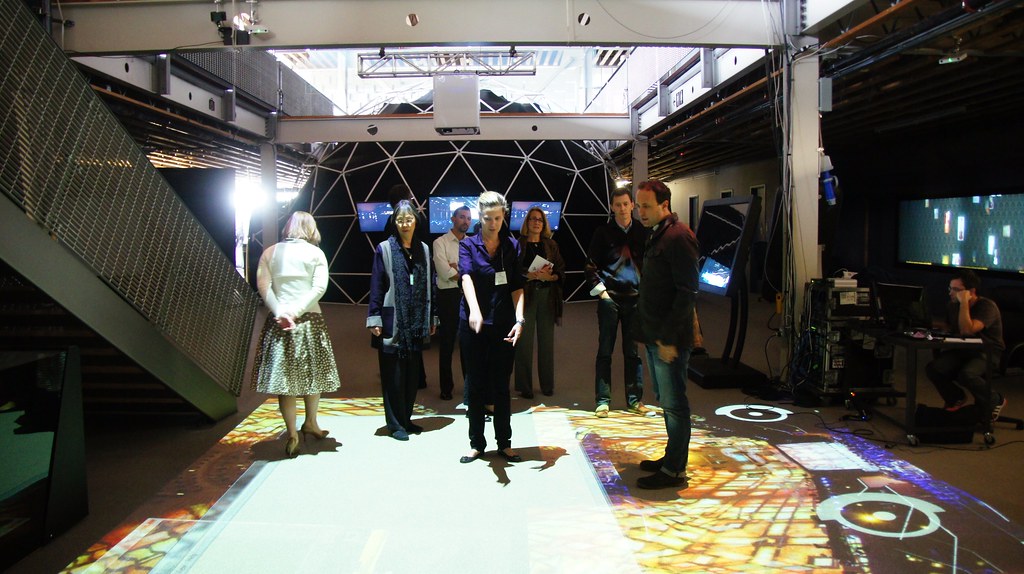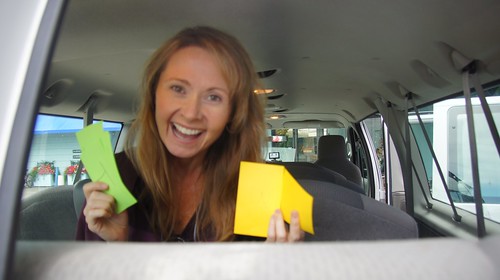
Obscura Digital, Innovation Learning Network 2011 View on Flickr.com
I have to hand it to the Innovation Learning Network (@HealthcareILN) Team, they create meetings that aren’t meetings, they are immersive learning experiences. That’s why I keep going back! That and they are always smiling.
The theme of this in person is “co-desinging the future of connected healing” and on day 1 we did the thing that is my favorite – learning from other industries and working to apply the best knowledge to health care. As I always say, if someone is doing something better than I, I want to know about it.

Christi Zuber (@czuber), Kaiser Permanente Innovation Consultancy (View on Flickr.com)
The (large) group was split up into teams that went to iconic and next generation innovation centers all over the bay area, from PARC to Citrix to Singularity University. Our group went to Obscura Digital ( @Obscura_Digital ), in San Francisco.
You’ve seen their work before, and my photographs don’t do it justice. “The world is their canvas” – from the Coca-Cola Building in Atlanta, to the CO2 cube in Copenhagan, they create hardware and software experiences that are immersive and full information and feeling. Some of the displays reminded me of the work at the Kaiser Permanente Center for Total Health (@kpcth), so there’s already some integration of this work into integrated care.
Today teams will be doing prototyping at the Sidney R Garfield Center for Healthcare Innovation (@KPgarfield), so this wasn’t just an observation trip. We need to create something today. I don’t know what that means, yet, but I will have my camera and tweeter with me. Hashtag is #iln11.
In the meantime, we were asked to think of insights we gained from this technology, which seems to, as Matthew Winnick from GravityTank said, “invert the technology.”
I am wondering how this could be used to help patients “be known” in the health care system (I am thinking Regina Holliday’s medical facts mural , enlarged to the size of a whole wall in a patient room). Our team actually spoke about this a bit – we are all familiar with the “I need to tell my story again and again when I visit the health care system,” but we went a little deeper in our group to discover that this situation is more than inconvenient, it can really disable empathy and really be traumatic.
Check out this video from Anna-Devere Smith’s “Let me down easy” about Dean Ruth Katz, Yale School of Medicine, and the experience of her admission to her own hospital as a cancer patient: You can see video of this piece here (go to 4:49).
Or, how could an environment for collective healing could be created in patient areas as well as the health professional areas of a medical setting. I think about what the sounds and visuals are for a busy nurse/physician and how that impacts their ability to be compassionate over time.
My photos are below, and below that a video of the CO2 cube in Copenhagan, enjoy, see what you think. What are your insights – how would you apply this technology to health and health care? No reason you can’t participate remotely….
CO2 Cube from Obscura Digital on Vimeo.
Okay, one more: a recent installation they did at Facebook F8 – how might this help people be “known”?
2 Comments
Innovation Learning Network Fall 2011 – co designing the future of connected healing: http://t.co/NHQ63FF8
Post: Innovation Learning Network Fall 2011-co-designing future of connected healing http://t.co/oM5budLi #iln11 @healthcareILN @kristenjuel